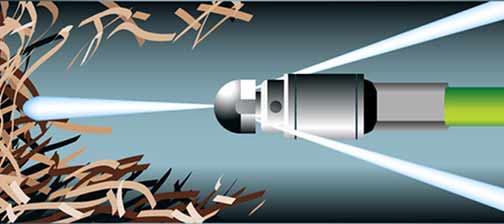
Drainage tiles play a crucial role in managing excess water around properties, whether residential, commercial, or agricultural. Proper maintenance is essential to ensure their longevity and functionality. Neglecting to maintain drainage tiles can lead to clogging, reduced efficiency, and potentially costly repairs. Here we discuss the most effective and professionally recommended methods to unclog and clean drainage tiles, ensuring they remain in optimal working condition.
Signs Indicating Clogged Drainage Tiles
Identifying the signs of clogged drainage tiles is pivotal in addressing the issue before it escalates. The following are common indicators that your drainage tiles may be blocked:
- Pooled water in areas where it usually drains well.
- Slow draining or water backing up in sinks, showers, or outdoor drains.
- Unpleasant odors emanating from drainage areas.
- Increased presence of pests around drainage areas.
If any of these signs are evident, it’s critical to take immediate action to clear the blockage and restore proper drainage functionality.
Manual Methods for Unclogging Drainage Tiles
Several manual methods can effectively unclog drainage tiles. These methods often require basic tools and can be performed without professional assistance:
- Plunger: A plunger is a common and effective tool for clearing minor clogs. Place the plunger over the drainage opening and push down firmly, then pull up repeatedly to dislodge the blockage.
- Drain Snake: A drain snake is a flexible, lengthy tool designed to reach deep into drainage pipes and break up or retrieve the source of the clog. Insert the snake into the drain and rotate it until the obstruction is cleared.
- Utility Hook: For surface-level blockages, a utility hook can be useful. Carefully insert the hook into the drainage opening and pull out any debris causing the clog.
Chemical Solutions for Cleaning Drainage Tiles
In some cases, chemical solutions can be highly effective in breaking down and removing blockages in drainage tiles. However, it’s important to use these chemicals responsibly to avoid damaging the pipes or the environment:
- Enzyme Cleaners: Enzyme-based cleaners use natural bacteria and enzymes to break down organic matter in drains. These cleaners are eco-friendly and safe for most types of pipes.
- Chemical Drain Cleaners: Strong chemical drain cleaners are available for tougher clogs. While effective, they should be used with caution. Always follow the manufacturer’s instructions and safety guidelines to prevent damage and ensure safety.
- Baking Soda and Vinegar: A homemade solution of baking soda and vinegar can also be effective. Pour baking soda followed by vinegar into the drain, let it sit for a few hours, then flush with hot water to clear the blockage.

Power Tools for Effective Drainage Tile Maintenance
Utilizing power tools can provide a more thorough and efficient solution to cleaning and maintaining drainage tiles, especially for significant clogs or extensive drainage systems:
- Hydro Jetting: This method uses a powerful stream of water to remove clogs and debris from drainage tiles. A hydro jetting machine can efficiently clean the inside of the pipes, restoring them to optimal condition.
- Electric Drain Auger: Similar to a manual drain snake, an electric drain auger can reach deeper and apply more force to clear tough clogs. This tool is particularly effective for larger drainage systems and persistent blockages.
- Camera Inspection: Before employing other power tools, a sewer camera inspection can be beneficial. A camera attached to a flexible cable is inserted into the drain to identify the exact location and nature of the clog, allowing for more targeted action.
Preventative Measures to Maintain Drainage Tiles
Implementing preventative measures can significantly reduce the likelihood of future clogs and ensure the long-term functionality of drainage tiles:
- Regular Cleaning: Regularly cleaning drains and removing debris can prevent buildup that leads to clogs. Simple actions like removing hair from shower drains and avoiding pouring grease down kitchen sinks can make a big difference.
- Installing Drain Guards: Drain guards can catch debris before it enters the drainage system, minimizing the risk of clogs. Install these guards on all drain openings to filter out larger particles.
- Scheduled Maintenance: Regular professional inspections and maintenance services can help detect and address potential issues before they become serious problems. Schedule maintenance checks at least annually.
The Role of Professional Services in Drainage Tile Maintenance
While many methods for unclogging and cleaning drainage tiles can be performed independently, professional services offer several advantages:
- Expertise and Experience: Professional plumbers and drainage specialists have the expertise and experience to tackle even the most stubborn clogs and ensure the drainage system is thoroughly cleaned.
- Advanced Equipment: Professionals have access to advanced tools and technology, such as hydro jetting machines and video inspection equipment, allowing them to perform more comprehensive and efficient maintenance.
- Long-Term Solutions: A professional service can provide long term solutions and recommendations for preventing future issues, potentially saving homeowners time and money in the long run.
Environmental Considerations in Drainage Tile Maintenance
Environmental responsibility is an important aspect of maintaining drainage tiles. Consider the following practices to ensure eco-friendly maintenance:
- Choosing Eco-Friendly Products: Opt for environmentally friendly cleaning products, such as enzyme-based cleaners, to reduce harm to the environment and water supply.
- Proper Waste Disposal: When clearing clogs, dispose of debris and chemical waste properly. Avoid washing harmful substances down drains, which can end up polluting water systems.
- Water Conservation: Use water judiciously during maintenance processes like hydro jetting. Implementing water saving techniques can also help reduce the overall strain on drainage systems.
Summing It Up
Effective maintenance of drainage tiles is critical to ensure their longevity and functionality. By recognizing signs of clogs, utilizing manual and chemical solutions, employing power tools, implementing preventative measures, and considering professional services and environmental responsibility, homeowners and property managers can keep drainage systems in top condition. Regular attention and care will lead to efficient water management and prevent costly repairs in the long run.

